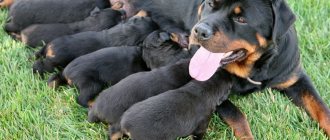Mastocytoma in dogs is a common malignant tumor that mainly affects the skin. It develops from mast cells (fat or mast cells), which are present in large numbers in the skin, fatty tissue, mucous membranes of the gastrointestinal tract and respiratory tract. They are a type of white blood cell that is embedded in connective tissue and is part of the immune system.
According to statistics, mastocytoma accounts for approximately 21% of all cases of malignant skin tumors in dogs.
It cannot be accurately diagnosed by its appearance, since it imitates other subcutaneous formations - warts, papules, nodules, crusts, lipomas, etc. It quickly passes from a calm stage to an aggressive one. Often ulcerates and causes itching.
Penetrates widely into adjacent tissues and quickly forms metastases. This is caused by the special structure of the mastocyte cell. Its cytoplasm contains a large amount of histamine, serotonin granules, and enzymes responsible for the development of various types of allergies.
With the development of systemic lesions of the body, mast cell leukemia or systemic mastocytosis develops. In this case, the cancer affects many organs and is characterized by symptoms: loss of appetite, vomiting, diarrhea, anemia, etc.
The following breeds are predisposed to mastocytoma: boxer, bulldog, beagle, Boston terrier, pit bull terrier, sharpei, golden retriever, Bernese mountain dog, English setter, dachshund. Most often, mastocytoma develops in old dogs (7-8 years old), regardless of gender. They account for 85% of all cases of mast cell tumors.
Kinds
There are mastocytomas:
- highly differentiated (grade 1) - rarely give metastases and relapses. Life expectancy, if detected early, is long;
- moderately differentiated or intermediate (grade 2). 10 - 22% of sick animals are affected by metastases. Life expectancy is average;
- low-grade (grade 3) - more than 80% of affected dogs are affected by metastases. Characterized by constant relapses. More than 70% of sick animals die.
More than 50% of tumors are localized on the torso, 25 - 40% on the paws, and about 10% on the head and neck. Rarely affects the oral mucosa and abdominal cavity.
According to the WHO classification, mastocytomas are classified into stages:
- 0 — according to histology results, the tumor was completely removed;
- I - limited single tumor without metastases in the lymph nodes;
- II - limited single tumor with metastases in the lymph nodes;
- III - multiple tumors or a large single tumor with or without metastases in the lymph nodes;
- IV - any tumor with distant metastases. They are distinguished both with and without general symptoms.
Symptoms of the disease
In half of the cases, mast cell tumor affects the skin on the dog's body, but can occur on the head, neck and face. Sometimes the disease manifests itself in the throat, digestive organs or nose. Because mastocytoma is difficult to diagnose, veterinarians often make a false diagnosis and prescribe the wrong treatment. Any new growth must be carefully studied.
Most often, mastocytomas appear as small nodules that cause itching. The dog begins to scratch them and the formations become red and inflamed. Hair loss is observed in the area of the tumor. When touching a tumor, the animal becomes anxious because it is quite painful. Mastocytoma develops both quickly and slowly.
Signs and diagnosis
In most cases, a mast cell tumor in dogs looks like a round growth on the skin, soft, mobile, up to three centimeters in diameter. It can manifest itself in the form of a single node or multiple neoplasms, accompanied by a lack of fur (alopecia), swelling and inflammation of surrounding tissues.
Grade 1 mastocytomas grow slowly. In the initial stage, they do not cause concern for either pets or owners. Second degree - often has signs of inflammation and skin erosion. The dog is experiencing severe itching. The scratched areas of the skin begin to fester. Tumors of the third degree are characterized by the appearance of red nodules when the formation itself and the skin nearby are rubbed (Darier syndrome).
When localized in the subcutaneous fatty tissue, mastocytoma is often misdiagnosed as a lipoma. Only cytology helps to make an accurate diagnosis.
As cancer progresses, it causes systemic reactions from the body. The gastrointestinal tract is most often affected. Up to the development of peptic ulcer disease. Reactions from the respiratory system in the form of rhinitis, bronchitis, and pneumonia are also possible. Leukocytosis and thrombocytopenia occur, which is dangerous for bleeding.
The tumor metastasizes to the lymph nodes, liver, spleen, and kidneys. Less commonly in the lungs and bone marrow.
Diagnosis of mastocytoma includes a medical history, a thorough examination of the animal, blood tests, cytological, immunohistochemical and other studies.
To determine the stage of the disease and the presence of metastases, an ultrasound of the abdominal cavity, a chest x-ray, a biopsy from regional lymph nodes, and bone marrow histology are performed.
The presence of symptoms of gastrointestinal tract damage indicates an advanced stage of mastocytoma.
Only a qualified doctor, based on the research carried out, can make a correct diagnosis, make a prognosis and select the optimal treatment regimen.
Mastocytoma in dogs
This is the name given to tumors formed by mast cells. In humans, this type of cancer is so rare that not every experienced oncologist encounters it in their practice, but dogs suffer from this type of oncology very often.
In appearance, these neoplasms seem small and relatively harmless, but in fact they pose a considerable danger to the dog’s body. Fortunately, with early detection and appropriate treatment, the chances of recovery are relatively high.
This is an important component of the entire immune system. They contain many proteolytic enzymes, heparin and, especially, histamine. They are not only capable of independently destroying many types of dangerous bacteria and viruses, but also facilitate the work of lymphocytes, increasing the porosity of blood vessels and opening the way to the epicenter of inflammation.
It is because of the substances they contain that mastocytomas are very dangerous. Because of histamine, heparin, and protein-degrading enzymes, removing them can cause a lot of problems for your dog when they are removed. The heart rate rises sharply and blood pressure rises. Postoperative wounds left after removal of these tumors heal very poorly and take a long time.
All dogs are predisposed, regardless of their breed and age. Unfortunately, the factor of heritability is clearly manifested. Brachycephalic dogs are most often affected. Golden retrievers also have a fairly high chance of getting sick. In 90% of cases, tumors are detected in elderly dogs.
The exact causes of tumors have not yet been studied. Most likely, viruses are to blame, as well as negative environmental factors. Veterinarians suggest that many years of research are needed to shed light on this problem. Since this type of cancer is extremely rare in humans, human oncologists also do not have useful information in the required volume.
The symptoms of mastocytoma in dogs can be very variable. Unlike other types of cancer, this type can be both benign and malignant, and tumors of these etiologies often develop in the neighborhood, bordering each other.
Typically, neoplasms develop in the abdomen, limbs, and genitals. They appear both on the skin itself and in the thickness of the subcutaneous tissue, which is worse.
They can be single, multiple, smooth or lumpy, and often have a pronounced tendency to ulceration.
Sick animals vomit, develop duodenal ulcers, and have blood in their stool. Blood clotting pathologies occur in 30-45% of dogs with this disease.
Note that such a severe clinical picture is typical specifically for mastocytomas.
They are destroyed, releasing histamine and proteolytic enzymes into the surrounding tissues, as a result of which the organs undergo severe degenerative changes.
Diagnostics
In order for the diagnosis to provide all the necessary information, it is extremely important to perform a biopsy. Since these tumors are usually easy to remove, pathological material is also examined. Based on the data obtained, a therapeutic technique is developed. Note that mastocytomas are divided into varieties. The higher the “grade”, the more dangerous the neoplasm:
- First type. Found in and on the skin, they are considered benign. Despite their relatively large size, they do not have a tendency to form metastases and are relatively easy to remove. Note that in 70% of cases, mastocytomas belong to this particular type.
- Second type. As a rule, they develop in the subcutaneous tissue. They have a tendency to degenerate into malignant ones, are quite aggressive, and after removal unpredictable consequences can develop.
- Third type. Malignant mastocytomas. They are located in the lowest layers of subcutaneous tissue and require immediate treatment.
Stages of the disease
It is very important to immediately determine the stage at which the disease is located before starting treatment. In many ways, the staging depends on whether the nearest lymph node is captured by the pathological process.
- Stage 0. One tumor in the skin, no lymph node involved.
- Stage I. One tumor in the skin, slightly larger, the lymphatic system is also not involved.
- Stage II. One tumor in the skin, there are small metastases in the lymph node.
- Stage III. Multiple large, deep skin tumors. Most often, there are metastases in the lymph nodes.
- Stage IV. Individual or multiple neoplasms and metastases are present not only in the lymphatic system, but also in the dermal layer. Every second poorly differentiated mastocytoma belongs to this type.
All stages can, in turn, be divided into two subtypes:
- There are clinical signs.
- There are no clinical signs.
Therapy
Treatment of mastocytoma in dogs depends on the individual characteristics of the animal, which must be taken into account when drawing up a plan for a therapeutic technique. The most common treatment is based on surgical removal of tumors.
This is a fairly simple and effective technique. It helps especially well if the tumor is type 1 or type 2. Note that when removing a tumor, it is important to capture part of the healthy tissue.
Since in many cases it is difficult to determine where the tumor begins and healthy tissue ends, a diagnostic resection is performed immediately before surgery.
The pathological material obtained during this procedure is subjected to histological examination.
Radiation therapy
If the tumor is of the third type, it is extremely important to complement surgical treatment with radiological therapy, which will destroy residual traces of metastases. It is believed that this approach significantly increases the survival rate of operated dogs. Until the tumors become diffuse, radiation therapy shows excellent results.
Chemotherapy
If the tumor has already reached the fourth stage and belongs to the third type, it is important to also include chemotherapy. Treatment with prednisone is also indicated.
In recent years, veterinarians have been doing a lot of research in the field of mast cell therapy.
In particular, they came to the conclusion that mistletoe therapy works well in some cases, despite the fact that some experts consider this method to be quackery. The principle of action of mistletoe has not yet been studied.
As for scientific methods, there are two types of drugs that have proven themselves in the treatment of mastocytes. This is a class of drugs called tyrosine kinase inhibitors.
They are prescribed strictly by a veterinarian and can be purchased in pharmacies only with a prescription.
They should be used strictly under the supervision of an experienced veterinarian, as serious side effects have been reported in some cases.
The prognosis depends on how far the disease has progressed. The lower the type and stage, the higher the likelihood of a successful outcome and full recovery of the dog. If the tumor is on the paw, the dog will most likely recover.
In the case where the neoplasm has developed in the mouth, on the face, or in the genital area, the likelihood of recovery is not so high.
Alas, tumors in the internal organs reduce the chances to zero, but in some cases surgical intervention helps.
Let us note once again that treatment will only be successful when the disease is detected in time, and its stage and type are determined.
Do not rely on “treatment” with traditional medicine, as this will only waste your time. In general, the same applies to all cases of oncology. If you notice anything unusual on your animal's body, contact your veterinarian immediately.
Source: https://vashipitomcy.ru/publ/sobaki/bolezni/mastocitoma_u_sobak/26-1-0-1320
Therapy
Main methods of treatment:
- surgical;
- hormone therapy;
- radiation therapy;
- chemotherapy.
Mastocytoma is difficult to treat. Mast cell tumors invade deeply into surrounding tissue. Therefore, surgical excision alone is not enough. More often than not, several methods are used simultaneously.
Before surgery, it is recommended to carry out hormonal blockades. They suppress the activity of inflammatory mediators. This leads to a shrinkage of the tumor and a decrease in its activity, which makes it easier to remove.
During excision, they retreat from the edges of the mastocytoma to a distance equal to three of its diameters. This can significantly reduce the risk of relapse. After surgery, histology of the wound edges is required to determine the presence of mast cells.
If it is impossible to operate on mastocytoma, chemotherapy is performed using various regimens using:
- prednisolone;
- vinblastine;
- lomustine;
- cyclophosphamide.
While taking them, anemia caused by suppression of hematopoiesis and intestinal disorders develop. To blunt reactions from the gastrointestinal tract, Omeprazole, Misoprostol, Sucralfate and other drugs are used.
Radiation therapy is used as both primary and additional treatment. Efficacy depends on cell differentiation and the size of the primary tumor. The larger it is, the lower the efficiency. Highly differentiated neoplasms are difficult to irradiate.
As a primary treatment, radiation therapy may be indicated for low-grade tumors that cannot be removed surgically by involving surrounding tissue. As an additional treatment, it is used in the preoperative period in an anti-inflammatory mode. After operations - for large tumors.
Mast cell tumor in dogs
According to the observations of practicing veterinarians, mastocytomas account for approximately 20-25% of tumors of the skin and subcutaneous tissues. Brachiocephalic dogs (boxers, Boston terriers, bullmastiffs, English bulldogs) and golden retrievers are at highest risk of developing mastocytes.
Mastocytomas may appear as dermoepidermal masses (i.e., superficial masses that move with the skin) or as subcutaneous masses (the overlying skin moves freely over the tumor).
They can imitate any primary or secondary skin lesions, including papules, nodules, crusts and others. Approximately 10-15% of canine mastocytomas are clinically indistinguishable from the usual subcutaneous lipoma.
Typically, mastocytomas cannot be definitively diagnosed by the appearance of the lesion and require cytological and histological studies.
Most mastocytomas are solitary, although multifocal lesions can occur in dogs. Regional lymphadenopathy caused by metastatic lesions also occurs in dogs with invasive mastocytosis. Rarely, dogs with systemic disease have splenomegaly and hepatomegaly.
Given the fact that mast cells produce large amounts of biologically active substances (mainly vasoactive), dogs with mastocytosis can be identified by diffuse edema (i.e. swelling and inflammation around the primary tumor or metastatic site), erythema and hematoma of the affected area .
From a histological point of view, mastocytomas are traditionally divided into 3 categories:
- highly differentiated (class 1)
- moderately differentiated (class 2)
- low differentiated (class 3)
From a molecular perspective, a variable percentage of dogs with mastocytoma have mutations in the c-kit gene, which is a stem cell growth factor receptor, and its mutation results in immortal clones that do not undergo apoptosis.
The biological behavior of mastocytes in dogs can be summed up in one word: unpredictability.
Lymphatic metastases can be present in normal-sized lymph nodes, so an aspirate should be taken from each lymph node in the affected area, regardless of whether it is enlarged or not. Metastases to the lungs are extremely rare.
Mastocytomas are more aggressive in certain locations than in others.
For example, mastocytomas of the distal extremities, inguinal or perineal mastocytomas have a higher metastatic potential than similar tumors in other regions.
Diagnostics
Evaluation of a dog suspected of having mastocytoma should include fine needle aspiration biopsy of the affected area and regional lymph node. Mastocytomas are easily diagnosed cytologically.
They consist of a monomorphic population of round cells with visible intracytoplasmic violet granules; Eosinophils are often present in the smear. In approximately one third of mast cellomas, the granules do not stain with Diff-Quick dye.
If aggressive surgical treatment is planned, cytology of the spleen and liver should also be performed.
Cytological diagnosis of mastocytoma on the lip in a poodle dog.
Treatment and prognosis
Mastocytomas in dogs are treated with surgery, radiation therapy and chemotherapy, or a combination of these methods. However, only the first two methods are potentially curative, and chemotherapy is only a half-measure.
Single tumors in the area to be surgically excised should be removed en bloc (2-3 cm around and below the tumor). If the excision is incomplete, one of three courses of action can be taken.
- Perform a second operation to completely excise the tumor. It is imperative to conduct a histopathological assessment of the removed area to ensure completeness of excision.
- Irradiation of the operated area (total dose 35-40 Gy for 10-12 sessions).
- Short course (3-6 months) of lomustine.
All of these 3 options are equally effective and provide an 80% chance of long-term survival.
Solitary mastocytomas may be located in an area where surgical excision is difficult or impossible, and they can be successfully treated with radiation therapy.
Intralesional corticosteroid injections (triamcinolone, 1 mg per cm of tumor diameter, intralesional, every 2–3 weeks) can also successfully reduce tumor size, although this is usually only palliative. Once the tumor has metastasized or disseminated, it is rare to cure an animal.
Treatment for these dogs consists of chemotherapy and supportive care aimed at relieving suffering and mitigating complications. Over the past few years, the drug lomustine has shown good results in dogs with unresectable, metastatic or systemic mastocytosis.
The response rate is greater than 40%, and remissions over 18 months have been documented in dogs with grades 2 and 3 mastocytomas. Lomustine may be used in combination with prednisolone, vinblastine, or both.
Lomustine is an effective drug for the treatment of mastocytes in dogs.
Chemotherapy Protocols for Dogs with Mastocytoma
- Prednisolone, 50 mg/m², orally, once a day for a week; then 20-25 mg/m², orally, once every 2 days for life + lomustine, 60 mg/m², orally, once every 3 weeks.
- Prednisolone, 50 mg/m², orally, once a day for a week; then 20-25 mg/m², orally, 1 time every 2 days for life + lomustine, 60 mg/m², orally, 1 time every 6 weeks, alternate with vinblastine, 2 mg/m², intravenously, 1 time every 6 weeks (the dog receives lomustine, after 3 weeks - vinblastine, after 3 weeks - lomustine again, and so on).
- Palladium (toceranib), 2.2-2.7 mg/kg, orally, Monday, Wednesday, and Friday; use in combination with gastroprotectors.
Although lomustine is a potentially myelosuppressive drug, clinically significant cytopenias are rare. Hepatotoxicity is common with its use. The addition of vinblastine allows the use of lomustine once every 6 weeks, which may lead to a decrease in hepatotoxicity.
Source: https://cytovet.ru/stati/zarubezhnye-publikacii/mastocitomy-u-sobak/
Forecast
The result of treatment and life expectancy depend on the stage of the disease, the type of tumor, the percentage of mutated cells and the effectiveness of chemotherapy. In older dogs, remission periods are shorter.
To determine the prognosis, it is important to classify mastocytoma and determine its differentiation.
Poorly differentiated tumors have a poor prognosis. Lifespan up to 12 months. For moderately differentiated ones - from one to three years. With highly differentiated ones, the prognosis is the most favorable. Life expectancy is significant.
A less favorable prognosis is given for tumors localized in the oral cavity and mucous membranes. Poor prognosis after surgical removal and/or radiation therapy of large tumors, with extensive invasion of surrounding tissues, rapid unregulated growth.
With systemic mastocytosis, the prognosis is unfavorable.
Systemic mastocytosis in animals
This is the name of a tumor that consists of mast cells (mast cells) and primarily affects the skin. A dangerous feature of mastocytoma is that it quickly turns into an aggressive form and metastasizes. Therefore, dog owners simply need to know about the signs of pathology, its diagnosis and forms of treatment.
Features of the disease
Oncological diseases have also been progressing among animals in recent decades. Veterinarians detect tumors even in young dogs. Mastocytoma is one of the most insidious diseases, because very often at the beginning it is disguised as a common allergy. It is worth noting that this type of tumor is detected very rarely in people. But it occurs often in dogs.
In appearance, the neoplasms at the initial stage seem harmless. However, in fact, they are very dangerous for dogs’ bodies. Mast cells, which form tumors, are components of the immune system. They contain histamine, heparin, proteolytic enzymes.
They destroy varieties of viruses and bacteria, making it easier for lymphocytes to work. Representatives of brachycephalic dog breeds are most often predisposed to mastocytoma. In 90% of cases, veterinarians detect pathology in older dogs. To date, the exact causes of mastocytoma have not been studied.
It is believed that under the influence of an unfavorable external environment, mast cells degenerate and become dangerous to animals.
About the symptoms of the disease
Signs of mastocytoma can be varied. This type of cancer can be either malignant or benign. In this case, both types of tumors can develop in the neighborhood, bordering on each other.
Most often they are diagnosed in dogs on the stomach, limbs, and genitals. They can appear both on the skin itself and in its thickness, that is, in the subcutaneous tissue. And this is the worst version of the disease.
Prevention
There is no specific prophylaxis that can prevent the disease. The only recommendation is to monitor the animal’s behavior and health status. Reason for an immediate visit to the doctor:
- anorexia;
- vomit;
- extreme exhaustion of the body;
- semi-liquid black stools with an unpleasant odor (melena).
A timely visit to a veterinarian will detect mastocytoma at an early stage. The earlier treatment is started, the more effective it is, and the prognosis is more favorable.
If surgical removal of the tumor was performed, the dog should be constantly monitored by an oncologist. The animal is brought in for examination every 6-8 weeks or every 21 days for chemotherapy. A blood test and biopsy in the area of surgery provide complete monitoring of the dog’s condition. Early detection of relapse increases the likelihood of successful treatment.
Breed predisposition
Mast cell tumor occurs with equal frequency in females and males, “loves” old dogs, from 9 years old. However, there is no guarantee that mastocytoma will not be detected in a pet until old age.
According to observations, signs of the disease are observed more often in the following breeds of dogs:
- Boxer, bulldog, pit bull terrier.
- Beagle, Shar Pei, English Setter.
- Boston Terrier, Labrador Retriever.
It is noteworthy that mastocytoma develops more often in short-haired and wire-haired breeds, possibly due to the effect of UV rays.
Preventive actions
Unfortunately, there is no way to prevent mast cell tumors from forming. The only recommendation for owners of dogs, especially those belonging to the risk group, is constant monitoring of the skin of their four-legged friend, checking for the presence of various seals. It would also be useful to regularly undergo tests and visit specialists.
Mastocytoma is a rather serious and complex problem both in terms of diagnosis and treatment. The disease requires quality study. What is mastocytoma in a dog, whether to operate on it or not, how to treat it and whether it is possible to cure it - such questions swarm in the head of every good owner. It all depends on the stage at which the disease was detected and on the results of the preliminary examination. With a favorable outcome of treatment, the four-legged friend has every chance of living a fairly long life (by dog standards).









